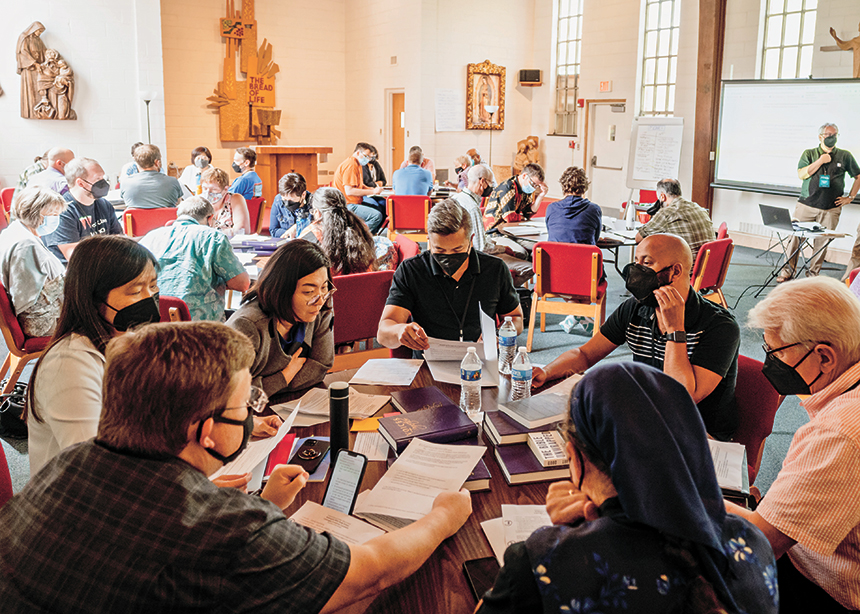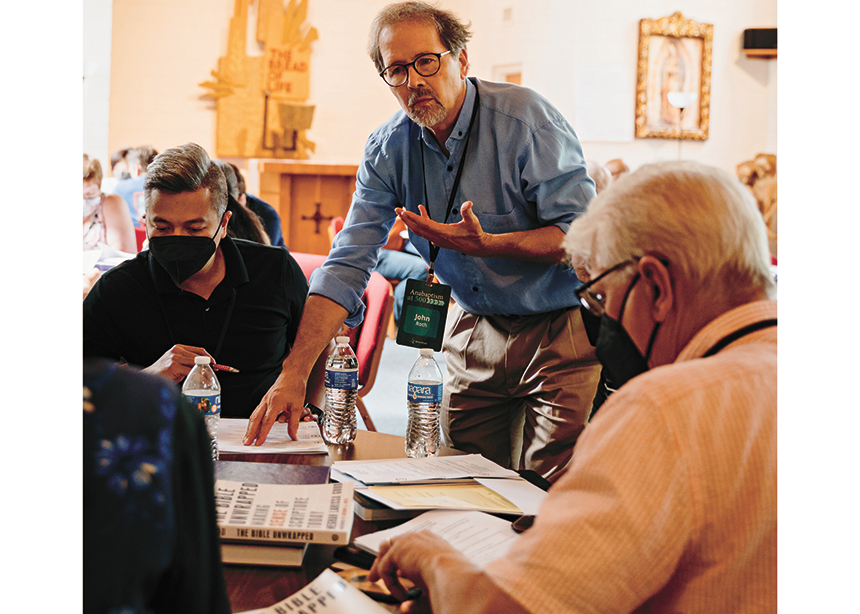Anabaptism began in 1525 in Switzerland, when bold young Christians challenged authorities with the radical idea that Scripture spoke clearly to ordinary people who studied the Bible together.
Nearly five centuries later, plans are taking shape for a special Bible to celebrate the 500th anniversary of Anabaptism and breathe new life into grassroots Bible study.
Forty-five people gathered from Aug. 26 to 28 at Casa Iskali retreat centre in the Chicago suburb of Des Plaines, Ill., for a working conference to launch the Anabaptist Bible, a project that aims to recapture the populist spirit—and Jesus-centred theology—of 16th-century Anabaptism.
It will be a “people’s Bible” that, if recruiting is successful, will draw on the work of 500 small groups of lay-people who will write marginal notes and commentary.
John D. Roth, a historian and former Goshen College professor who directs the project, admits the plan is daunting in its size and speed: The editors want all content submitted by June 15, 2023.
“Gutsy” is how one conference participant, retired filmmaker Elam Stoltzfus of Reading, Pa., described it. “We’ll pray for wisdom,” he said. “I’m excited about this project. I’m honoured to be a part of it.”
A project of MennoMedia, the publishing arm of Mennonite Church Canada and MC U.S.A., the Anabaptist Bible aims to reflect the diversity of many groups while drawing the bulk of its support from these two denominations.
The greatest number of people at the meeting were from MC U.S.A. Besides MC Canada, others came from the Church of the Brethren; LMC (formerly Lancaster Mennonite Conference); Evana, an evangelical Anabaptist body; and the Bruderhof, a Plain communal group.
Organizers hope the project will grow to include the Mennonite Brethren, Brethren in Christ and others.
“We hope ‘Anabaptism at 500’ can be a big tent,” Roth said, referring to the anniversary plans of which the Anabaptist Bible is a part. “There are many streams in the Anabaptist tradition, and we want to hear from each other and learn from each other.”
While open to contributions from the rest of the world, the Anabaptist Bible is a project by North Americans for North Americans, in English. “Our commitment is to the diversity of Anabaptists in North America, which is already a tremendous challenge,” Roth said.
While seeking diverse voices, the Anabaptist Bible will centre on a unifying theme: Christ-centred biblical interpretation. Or, in scholarly terms, a “Christocentric hermeneutic.”
In two presentations, Meghan Larissa Good, pastor of Trinity Mennonite Church in Glendale, Ariz., and author of The Bible Unwrapped: Making Sense of Scripture Today (Herald Press, 2018), described the interpretive method as “putting on our Jesus glasses.”
Reading Scripture through a Jesus lens, Good said, is not only the Anabaptist way but reflects the theology of the early church.
“The goal of Scripture, according to the early Christians, is to lead people to an encounter with the living Christ,” she said. “We are connected to this living person who is present. If we have a person we are being drawn toward, that becomes our anchor point, and we have space for conversation around it.”
Good said that Jesus is the principle by which biblical differences are mediated, and “the logic of Scripture’s narrative arc.” She cited John 1:1, which says Jesus is the original Word, the logic behind creation; Hebrews 1:1-3, which says God spoke to us through a Son who is “the exact imprint of God’s very being”; and Colossians 1:19, which says “all the fullness of God was pleased to dwell” in Jesus.
“Jesus is not the softer side of God that gets averaged” with the God of judgment and wrath, Good said. Jesus is the fullness of God, the authoritative interpreter of Scripture.
With this Christ-centred theology in mind, 500 study groups will get a “3-4-5” assignment: read three passages of Scripture (the entire Bible will be divided into 500 sets of three passages and assignments given), meet four times and respond to five discussion prompts:
- What does the verse or passage suggest about God?
- What might/does Jesus say about it?
- What does the verse or passage suggest about humans—our possibilities and mistakes?
- How are we called to live differently because of this verse or passage?
- What additional questions or comments remain with you (or your group)?
In the spirit of a people’s Bible accessible to readers from diverse backgrounds, the Anabaptist Bible will use the Common English Bible translation. This translation uses simpler language than the New International and New Revised Standard versions. It has become popular with immigrants and is easy to read aloud. Since few Anabaptists own the Common English Bible, reading a new translation might stimulate interest.
Study groups that sign up to participate can use any version of the Bible they choose.
Conference participants, some with an academic background in biblical scholarship, advised the project organizers, led by Roth and Mollee Moua, managing editor of “Anabaptism at 500,” on matters of theology as they finalized introductory materials for study groups.
Some cautioned that guiding the groups to interpret the Old Testament through a “Jesus lens” must not promote supersessionism. Also known as replacement theology, supersessionism holds that Christians have replaced Jews as God’s people, and this view often aligns with antisemitism.
What the study groups might say about sexuality was cited as a potential problem. Emmy Maendel of Maple Ridge Bruderhof near Kingston, N.Y., who noted that she was the only conference participant from a Plain group, warned about nontraditional views on transgender people and same-sex marriage. “If that comes into this Bible, there are a lot of people who will never buy it,” she said.
Hyejung Yum of Toronto urged that the Anabaptist Bible reflect the global church and contemporary concerns, even though North Americans will produce it and a celebration of history underlies it.
“When we only talk about the 16th century, we maintain a Eurocentric identity,” she said. “Our global identity is more than European descendants, so we need to intentionally work on including that if we want to move forward to the future.” (For more on Hyejung Yum’s thoughts on this issue, visit
canadianmennonite.org/hjy.)
Gerald Mast, professor of communication at Bluffton (Ohio) University, affirmed the project and testified that daily Bible reading, through all of Scripture (“I have to read the passages that make me uncomfortable”), made him a more welcoming, enduring and less anxious person.
“I am thrilled to be part of a Bible project that will bring the diversity of the church together with the diversity of the Bible, and that will attend to the familiar and the neglected corners of the Bible with the ordinary and gathered communities of the church,” he said. “I’m convinced that this Bible will encourage not just Anabaptists, but the whole Body of Christ, toward a greater endurance and a greater welcome.”
Paul Schrag is editor of Anabaptist World. Reprinted by permission of Anabaptist World. For more information and to register a group, visit anabaptismat500.com.
FAQs about the Anabaptist Bible
By John D. Roth
What is it?
MennoMedia, the publishing agency of Mennonite Church Canada and MC U.S.A., is producing the first-of-its kind Anabaptist Bible by publishing the Common English Bible version of the Bible with contributions from Anabaptists embedded as notes, book introductions and more. This project is an effort to help readers understand what it means to read Scripture through the distinctive “Jesus-centred” lens of the Anabaptist tradition.
Why is this Bible needed?
For many Christians today, the Bible has become a battlefield or is regarded as irrelevant. Yet the central story of Scripture—that God has been revealed to the world in the person of Jesus Christ—is good news. Amid the confusion and anxiety over Scripture, Christians need to be reminded that the Bible always puts them into a relationship with a living person. The saving message of Christ’s life, death and resurrection echoes throughout all of Scripture. The gift of this transformative story far exceeds debates over specific verses, and it still has the power to transform lives today.
Who thought of this?
In late 2021, MennoMedia launched an initiative called “Anabaptism at 500” as a way of inviting a wide spectrum of Anabaptist groups to commemorate the 500th anniversary of Anabaptist beginnings (1525-2025). Early in that planning, the idea emerged that an Anabaptist Bible would be a crucial component of that commemoration, especially considering the vital role Scripture played in the emergence of the Anabaptist tradition in the 16th century and its development since then.
How will it work?
The reflections, insights, questions and commentary that are a crucial part of the Anabaptist Bible will be generated largely by ordinary members of the church. The entire Bible has been divided into 500 clusters of texts—each with an Old Testament and a New Testament passage, along with a portion from the Psalms or Proverbs. Interested study groups will be assigned three biblical passages. Each group will meet regularly for conversation. A group representative will then compile and submit the group’s reflections, insights and questions. Those submissions, along with other materials compiled by the editors, will become the core content of the Anabaptist Bible.
Who will contribute to it?
The introductions to the books of the Bible, along with essays and artwork, will be assigned to individuals who bring particular gifts to those tasks. But the primary content of the Anabaptist Bible will be generated by Bible study groups from at least 500 Anabaptist congregations or faith communities, representing a diverse spectrum of contemporary Anabaptists. The expectation is that these participants will be earnest Christians, ready to engage with their assigned texts in thoughtful conversation with each other through the lens of an Anabaptist hermeneutic. Participants are not required to have seminary degrees or to possess unique gifts in biblical interpretation.
What’s the schedule?
Groups interested in participating can register at anabaptismat500.com. They will receive detailed instructions for both the facilitator of the study group and for each participant. Ideally, groups will complete their work in four to five weeks. Registration closes on March 1, 2023, and all annotations must be submitted by June 15, 2023.
How can I and my congregation help?
The easiest way to help is by participating. If you are intrigued by the idea of helping to create the Anabaptist Bible, share your enthusiasm with your pastor and encourage your Sunday school class or small group to sign up. You can also help by supporting the project with a donation. Watch for other “Anabaptism at 500” items currently in development.
 John D. Roth is the project director of “Anabaptism at 500.”
John D. Roth is the project director of “Anabaptism at 500.”
![]()
Related story:
Cultural markers and faith markers
For discussion
1. What is your go-to version or translation of the Bible? How helpful do you find a Bible that includes notes at the bottom or commentary in the margins? What do you find appealing about the idea of an Anabaptist “people’s Bible”?
2. The purpose of the Anabaptist Bible project is to provide a Christ-centred biblical interpretation. What are some examples where Jesus reinterpreted Old Testament passages or ideas? What does it mean to put on your “Jesus glasses”? Are some parts of the Bible more important than others?
3. Hyeyung Yum of Toronto expressed concern that this Bible project not concentrate on the 16th century, but reflect the global church and contemporary concerns. What were some of the issues that Anabaptists in the 16th century were concerned about? Do you think they would agree with Yum?
4. The Anabaptist Bible project will have ordinary people think about specific Bible passages, reflecting on the roles of God, Jesus and humans. Would you be interested in studying the Bible this way? How interested are you in reading what other Mennonites have to say about Bible passages?
5. How would you go about trying to “breathe new life into grassroots Bible study”?
—By Barb Draper









Leave a Reply
You must be logged in to post a comment.